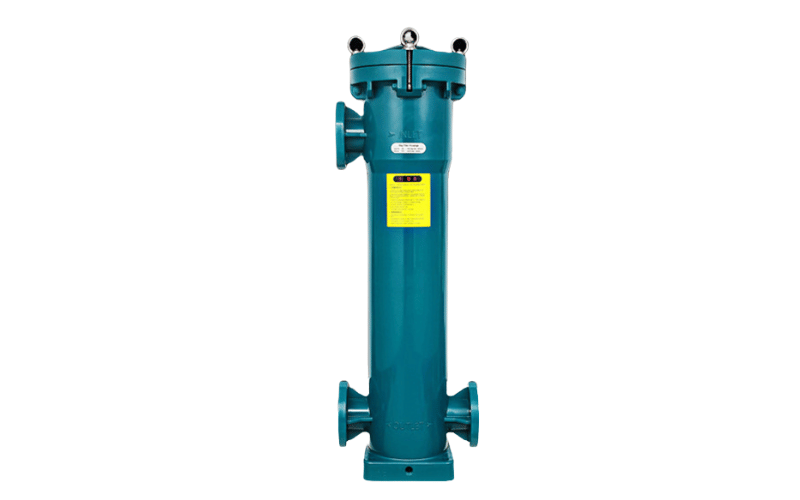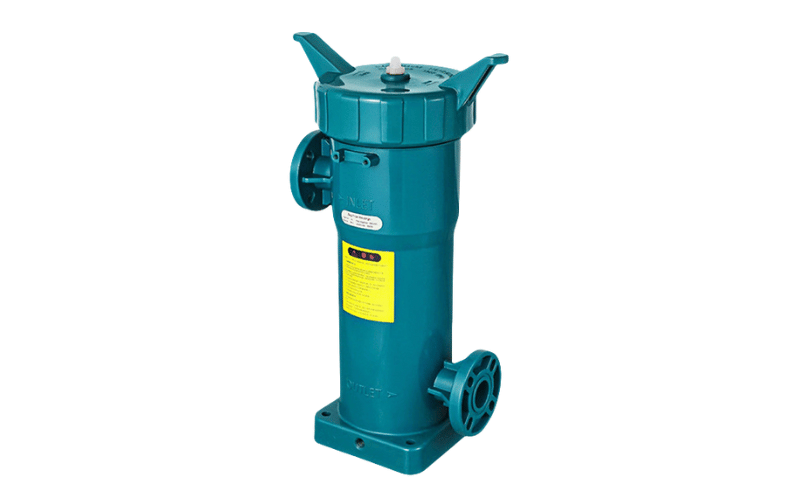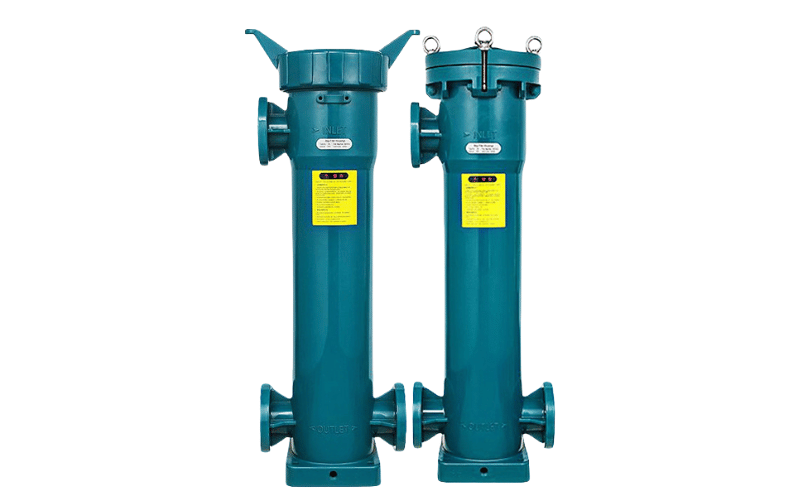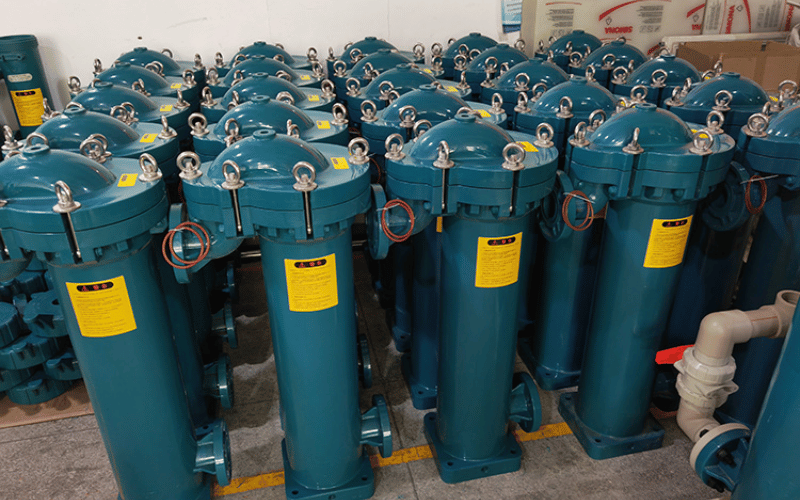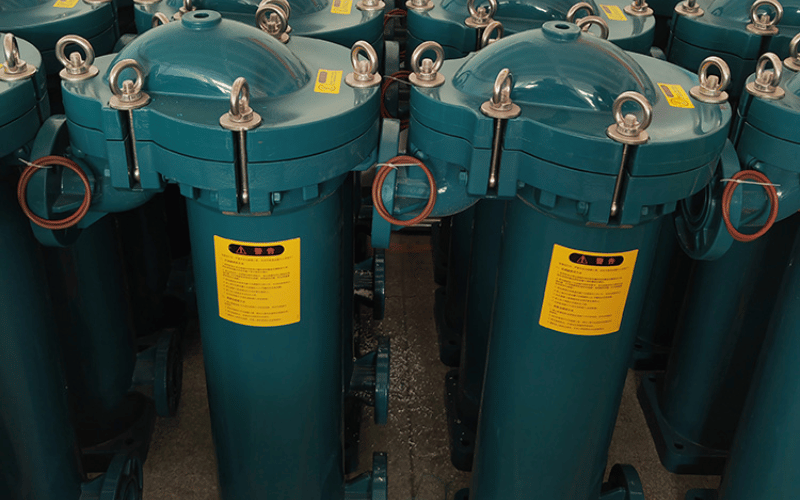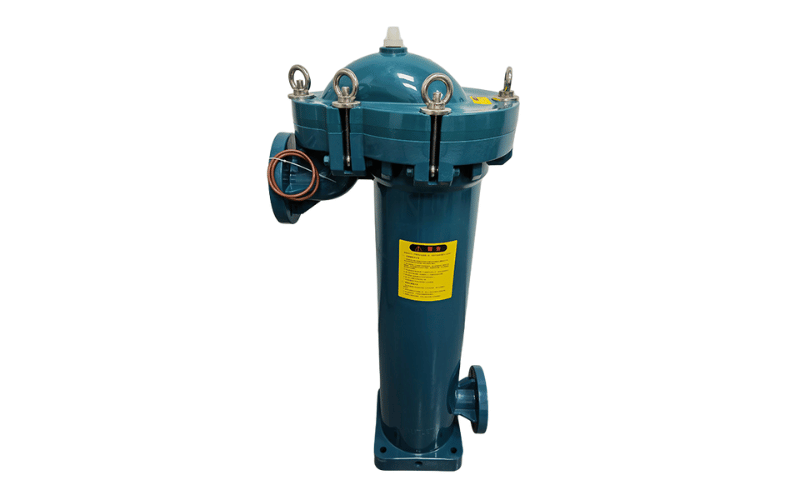Polypropylene Filter Housing
Home » Filter Housing » Polypropylene Filter Housing | Durable & Chemical-Resistant Solutions
Efficient Filtration | Long Service Life | Customizable Options
The Polypropylene Filter Housing is a reliable and high-performance solution for liquid filtration. Made from durable polypropylene, it is built to handle tough conditions, including chemical exposure and environmental changes. With no metal components, it eliminates the risks of rust, corrosion, and contamination, making it perfect for applications that demand high purity and durability.
This filter housing is compatible with standard filter bag sizes, including 1#, 2#, 4#, and 5#. You can choose from a variety of filter bag materials, such as polypropylene, polyester, nylon, polyamide, PTFE, and polyester fabric, offering flexibility for different filtration needs.
The system operates using pressure-driven filtration. Liquid enters through a side-mounted inlet pipe, flows into a filter bag supported by a reinforced mesh, and passes through the bag at the desired filtration level. Impurities are effectively captured, ensuring efficient and eco-friendly filtration. Plus, replacing filter bags is quick and hassle-free.
Get Your industrial filtration solutions Today.
Technical Specifications of Polypropylene Filter Housing
| Brand Manufacturer | Top Filter Bag |
|---|---|
| Housing Material | PP |
| Type | Bag Filter |
| Design Pressure | 0.6 MPa |
| Design Temperature | 10°C to 80°C |
| Opening Method | Clamp, Flange |
| Filter Precision | 0.5 µm to 100 µm |
| Lid Opening Method | Threaded Rolled |
| Sealing Material | Nitrile Rubber, Silicone Rubber, Fluorinated Rubber |
| Connection Type | Flange |
| Sealing Type | O-Ring and Flat Gasket |
| Filter Cartridge Type | Filter Bag |
| Reference Flow Rate | 10 to 40 t/h |
| Number of Filter Bags | Depending on flow rate |
Key Features for Polypropylene Filter Housing
Seamless One-Piece Design
Eliminates welded joints, ensuring zero leakage and maximum reliability.
Top-Entry Flow Design
Promotes even flow distribution, optimizing impurity retention and filtration efficiency.
High Filtration Precision
Captures particles as small as 0.5 μm for exceptional filtration quality.
Low Leakage Risk
Ensures consistent filtration with minimal side leakage.
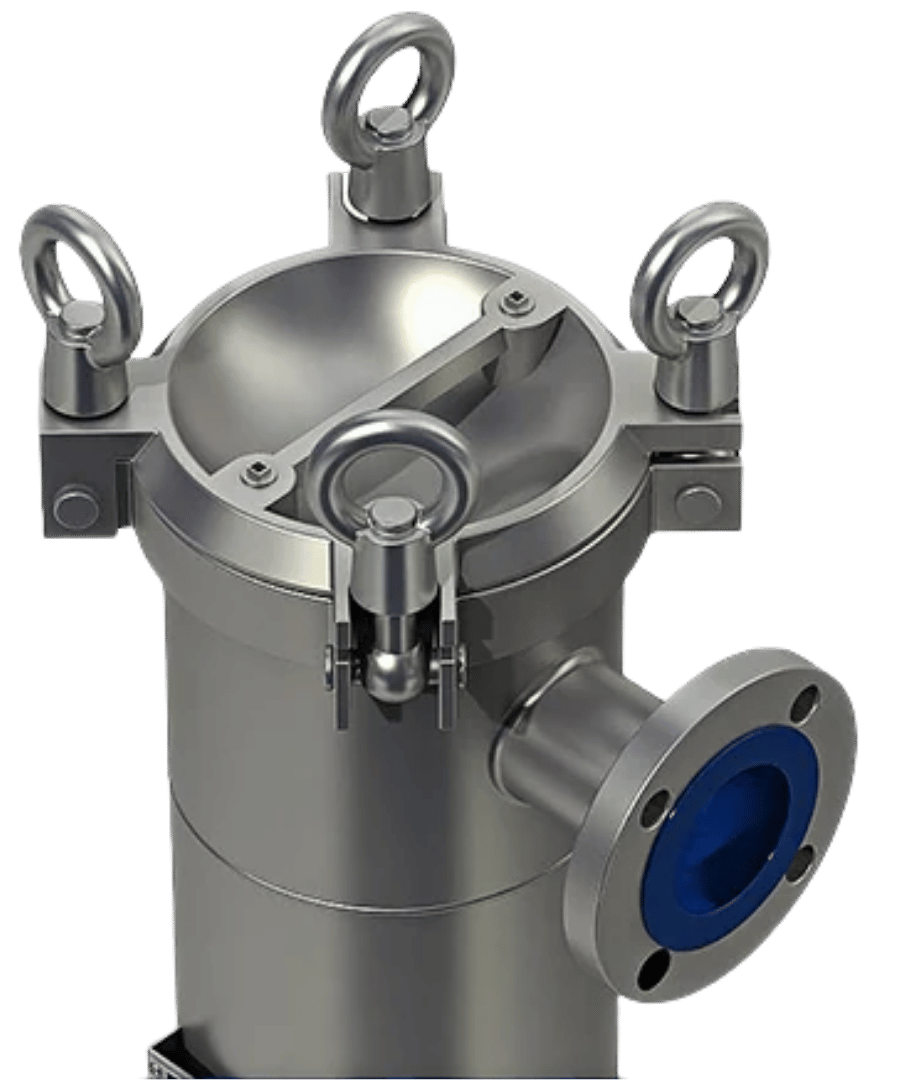
Durable Polypropylene Construction
Built with premium materials for long-lasting performance and chemical resistance.
Extended Filter Bag Lifespan
High open-area support mesh maximizes usable filter area, reducing replacements.
Cost-Effective & Reusable
Washable filter bags reduce operational costs and environmental waste.
Easy Maintenance
Quick filter bag replacement minimizes downtime and labor effort.
Application Areas
The Polypropylene Filter Housing is versatile and ideal for use across various industries, including:
- Metalworking
Perfect for processes like hydraulic oil filtration, cleaning parts, metalworking fluids, and mixtures. - Electronics
Widely used in PCB manufacturing for nickel plating, gold plating, etching, and acid-base washing. Suitable for wafer production, electronic etching tanks, and high-purity water filtration. - Chemical Industry
Effectively recovers catalysts and filters acidic and alkaline solutions, solvents, emulsions, dispersions, and colloids. Removes activated carbon and paint clumps with ease. - Foil Manufacturing
Suitable for copper and aluminum foil production, ensuring clean liquid processes.
Whatever the application, the ease and efficiency of this system make it indispensable for achieving clean, reliable filtration while reducing costs and downtime. Enhance your processes with the Polypropylene Filter Housing, crafted to meet the most demanding filtration requirements.
How to Choose the Right Polypropylene Filter Housing?
Why Choose Polypropylene Filter Housings?
Polypropylene filter housings are the go-to solution for industries requiring durability, chemical resistance, and reliable filtration. Whether you’re dealing with aggressive chemicals, extreme pH levels, or high-pressure environments, these housings ensure optimal performance and longevity.
Understanding Your Filtration Needs
Choosing the right filter housing starts with understanding your specific requirements:
- Liquid Type & Composition: Polypropylene is ideal for filtering liquids with aggressive chemicals or extreme pH levels due to its corrosion resistance.
- Operating Conditions: For high-pressure or elevated temperature processes, polypropylene housings offer robust construction and reliability.
- Filtration Precision: Our filter bags provide precision as fine as 0.5 μm, ensuring even the most stringent filtration needs are met.
Key Factors to Consider
Size and Capacity:
- Match the housing size to your liquid volume.
- Compatible with standard filter bag sizes (1#, 2#, 4#, 5#) for small to large-scale operations.
Flow Rate:
- Ensure the housing can handle your process’s flow rate without compromising filtration efficiency.
- Our housings are designed for consistent flow paths, even at high speeds.
Outlet Configuration:
- Our side-in, top-out flow design optimizes filtration, extends filter bag life, and minimizes leakage risks.
Single Bag vs. Cartridge Filter Housings
Single Bag Filter Housings:
- Cost-effective and easy to use.
- Ideal for moderate to high contaminant loads.
- Reusable filter bags reduce material costs and simplify maintenance.
Cartridge Filter Housings:
- Designed for high-precision filtration and multi-stage processes.
- Perfect for industries like pharmaceuticals and ultrapure applications.
- Higher operational costs due to frequent replacements.
| Feature | Single Bag Filter Housing | Cartridge Filter Housing |
|---|---|---|
| Best For | Cost-effective, versatile use | High-precision filtration |
| Maintenance | Easy, reusable filter bags | More frequent replacements |
| Applications | Moderate to high contaminant loads | Ultrapure and fine filtration |
Making the Right Choice
Selecting the right polypropylene filter housing doesn’t have to be complicated. By focusing on your unique application needs, operating conditions, and long-term goals, we ensure you get the best solution tailored to your requirements.
Contact us today to explore how our Polypropylene Filter Housings can enhance your processes and maximize efficiency.
What Types of Filter Cartridges are Compatible with Polypropylene Filter Housings?
Our polypropylene filter housings are versatile and compatible with a wide range of filter cartridges, including:
- Pleated Cartridges: High dirt-holding capacity and fine particle filtration.
- Melt-Blown Cartridges: Gradient-density filtration for sediment and rust removal.
- String-Wound Cartridges: Durable and ideal for viscous liquids or high sediment levels.
- Activated Carbon Cartridges: Removes odors, tastes, and organic compounds.
Benefits of Virgin Polypropylene Cartridge Filters
Using virgin polypropylene cartridge filters ensures superior performance and longevity:
- Chemical Resistance: Withstands acids, bases, and solvents.
- Enhanced Durability: Handles pressure variations without structural compromise.
- Non-Leaching: Maintains purity in sensitive applications.
- Thermal Stability: Performs well in high-temperature environments.
Applications for Different Cartridge Types
| Cartridge Type | Best For |
|---|---|
| Pleated Cartridges | Fine filtration in electronics manufacturing and high dirt-load processes. |
| Melt-Blown Cartridges | Potable water systems, reverse osmosis pre-filtration, and industrial liquids. |
| String-Wound Cartridges | Oil and gas processing, adhesives, and paints/coatings industries. |
| Activated Carbon Cartridges | Food production (removing tastes/odors) and water treatment. |
Why Choose Our Polypropylene Filter Housings?
Our housings are designed to optimize the performance of these cartridge types, ensuring:
- Seamless integration with your system.
- Maximum filtration efficiency.
- Reliable, cost-effective solutions tailored to your needs.
Contact us today to explore how our polypropylene filter housings and compatible cartridges can enhance your filtration processes.
How to Install and Maintain Polypropylene Filter Housings?
Installation Tips
Proper installation ensures optimal performance and longevity. Follow these steps for a seamless setup:
Inspect Components:
- Check gaskets, seals, and connections for damage before installation.
Position the Housing:
- Mount vertically in a stable, accessible location with enough clearance for easy filter replacement.
Prepare the Piping System:
- Align inlet and outlet connections with your pipeline. Use compatible fittings and avoid over-tightening.
Install the Filter Media:
- For bag housings, seat the filter bag securely in the support basket. For cartridge housings, insert cartridges carefully to prevent misalignment.
Seal the Housing:
- Ensure gaskets or O-rings are properly seated and the housing is tightly sealed to prevent leaks.
Perform a System Check:
- Run fluid through the system at low pressure to check for leaks or misalignments before full operation.
Maintenance Best Practices
Routine maintenance keeps your filter housing running efficiently. Follow these tips:
- Inspect Regularly: Check for wear, cracks, or leaks in the housing, seals, and gaskets.
- Clean Periodically: Remove residue from inner components to prevent clogging.
- Replace Filter Media: Monitor and replace filter bags or cartridges when filtration efficiency drops.
- Flush the System: Periodically flush with a compatible cleaning solution to prevent blockages.
- Monitor Pressure: Use differential pressure gauges to track pressure drops and identify when media replacement is needed.
Troubleshooting Common Issues
Here’s how to address common challenges:
- Leaks: Check seals, O-rings, and lid tightness. Replace damaged components.
- Reduced Flow Rate: Replace clogged filter media or flush the system to remove blockages.
- Pressure Drops: Verify proper media installation and ensure the filter hasn’t exceeded its capacity.
- Uneven Filtration: Inspect filter alignment and replace damaged support baskets.
- Frequent Media Replacement: Check for side leaks or upgrade to higher-capacity filters.
Why Choose Our Polypropylene Filter Housings?
Installing and maintaining polypropylene filter housings is simple with our user-friendly designs. By following these steps, you’ll ensure efficient, reliable operation across a range of applications.
Need help? Contact us for expert support and discover how our solutions can enhance your filtration processes.
FAQs About Polypropylene Filter Housing
Q: What are the key features of polypropylene filter housings?
A: Polypropylene filter housings are designed with various features that include durability, resistance to corrosion, and compatibility with a wide range of liquids. They often come with options for vents, drains, and pressure gauges to monitor differential pressure, ensuring optimal performance in various industrial applications.
Q: Are pure polypropylene filter housings suitable for chemical applications?
A: Yes, pure polypropylene filter housings are resistant to a variety of chemicals, making them a suitable choice for applications in industries such as pharmaceuticals and chemical processing. However, it is essential to confirm compatibility with the specific chemicals being used.
Q: What is the maximum psi rating for polypropylene housings?
A: The maximum psi rating for polypropylene housings can vary depending on the manufacturer and specific product design. Generally, they can handle pressures up to 150 psi, but it is crucial to consult the product specifications to ensure safe operation within your application.
Q: Can polypropylene filter housings be used for both liquid and gas applications?
A: Yes, polypropylene filter housings can be utilized for both liquid and gas applications. Their versatile design allows them to effectively filter different media, although attention should be paid to the specific requirements and pressure ratings of the application.
Q: What types of filter bags are compatible with polypropylene filter housings?
A: Various types of filter bags can be used with polypropylene filter housings, including nylon mesh and other fabrics designed for filtration. It is important to select filter bags that are compatible with the housing's design and the specific filtration requirements of the application.
Q: How do I clean polypropylene filter housings?
A: Polypropylene filter housings are easy to clean due to their smooth surfaces and resistance to mold and contamination. To clean, disassemble the housing, rinse it with water, and use a mild detergent if necessary. Ensure all components are thoroughly dried before reassembly.
Q: What should I consider when selecting an adapter for polypropylene filter housings?
A: When selecting an adapter for polypropylene filter housings, consider the size and threading of the pipe connections, the type of fluid being filtered, and the housing's specifications. Ensuring a proper fit will help maintain a secure seal and prevent leaks.
Q: Are there any specific mounting requirements for polypropylene filter housings?
A: Yes, polypropylene filter housings typically require a stable surface for mounting. It is advisable to use a mounting bracket that can support the housing's weight and maintain alignment with the pipe connections. Proper installation is crucial to avoid stress on the housing and potential leaks.


